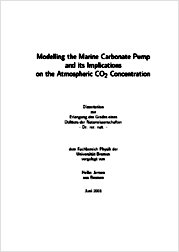| dc.contributor.author | Jansen, Heiko | |
| dc.date.accessioned | 2010-10-12T18:55:19Z | |
| dc.date.available | 2010-10-12T18:55:19Z | |
| dc.date.issued | 2001 | |
| dc.identifier.uri | http://hdl.handle.net/11858/00-1735-0000-0001-3162-2 | |
| dc.description.abstract | The marine carbonate pump includes the production of calcium carbonate, CaCO3 by marine organisms and its subsequent transport to depth. The balance between carbonate production in surface waters and dissolution and accumulation in sediments influences the surface water CO2 concentration and thus the oceanś capacity to take up atmospheric CO2.Models are developed to investigate on calcium carbonate dissolution in the oceanic water column. Model results yield that dissolution in zooplankton guts contributes a significant portion of the proposed carbonate loss. Dissolution fueled by the respiration of organic matter in marine snow aggregates is very sensitive to the size and settling velocity of the aggregate, which determines the boundary layer thickness and the stability of an undersaturated microenvironment. The constraints set by field data yield that the chemical gradients between the aggregate and the bulk seawater are too small to enable significant carbonate dissolution. Furthermore, the role of the carbonate pump in regulating atmospheric pCO2 on glacial to interglacial timescales is investigated ... | |
| dc.format.extent | 132 S. | |
| dc.format.mimetype | application/pdf | |
| dc.language.iso | eng | |
| dc.publisher | Univ. Bremen | |
| dc.rights.uri | http://e-docs.geo-leo.de/rights | |
| dc.subject.ddc | 551.9 | |
| dc.subject.gok | VJI 000 | |
| dc.title | Modelling the marine carbonate pump and its implications on the atmospheric CO2 concentration | |
| dc.type | monograph | |
| dc.subject.gokverbal | Geochemische Kreislaufmodelle | |
| dc.identifier.doi | 10.23689/fidgeo-218 | |
| dc.identifier.ppn | 342782614 | |
| dc.type.version | publishedVersion | |
| dc.relation.collection | Geologische Wissenschaften | |
| dc.description.type | thesis | |


